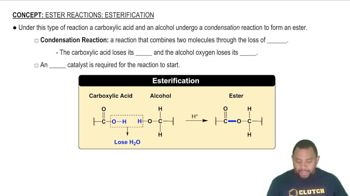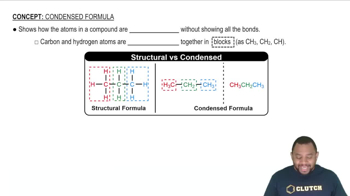Here are the essential concepts you must grasp in order to answer the question correctly.
Esterification Reaction
Esterification is a chemical reaction that forms an ester from a carboxylic acid and an alcohol. This process typically involves a condensation reaction, where a water molecule is eliminated as the ester bond is formed. The general reaction can be represented as RCOOH + R'OH → RCOOR' + H2O, where R and R' are hydrocarbon chains. Understanding this reaction is crucial for identifying how esters are synthesized.
Recommended video:
Ester Reactions: Esterification
Polyester Formation
Polyester formation involves the repeated esterification of diacids and diols, leading to long-chain polymers. In this process, each reaction between a carboxylic acid and an alcohol results in the release of water, allowing the formation of a polymeric structure. This concept is essential for understanding how small ester molecules can link together to create larger, more complex materials, such as plastics and fibers.
Recommended video:
Condensation Reaction
A condensation reaction is a type of chemical reaction where two molecules combine to form a larger molecule, accompanied by the loss of a small molecule, often water. This reaction is fundamental in organic chemistry, particularly in the formation of esters and polymers. Recognizing the role of condensation reactions helps in understanding how various organic compounds can be synthesized and how they interact in larger molecular structures.
Recommended video:
 Verified step by step guidance
Verified step by step guidance

